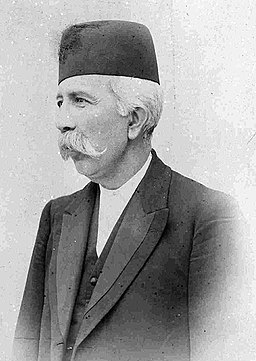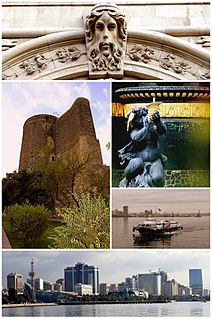
Azerbaijani or Azeri, also sometimes referred to as Azeri Turkic or Azeri Turkish, is a term referring to two Turkic lects that are spoken primarily by the Azerbaijanis, who live mainly in Transcaucasia and Iran. North Azerbaijani and South Azerbaijani have significant differences in phonology, lexicon, morphology, syntax, and loanwords. ISO 639-3 groups the two lects as a "macrolanguage".

Sayyed Ja'far Pishevari was the founder and chairman of separatist and communist Azerbaijan People's Government, created and supported by Soviet occupational forces in north-western Iran.

The Azerbaijan People's Government was a short-lived unrecognized secessionist state in northern Iran from November 1945 to December 1946. Established in Iranian Azerbaijan, the APG's capital was the city of Tabriz. Its establishment and demise were a part of the Iran crisis, which was a precursor to the Cold War.

The Azerbaijan Democratic Republic, also known as Azerbaijan People's Republic or Caucasus Azerbaijan in diplomatic documents, was the third democratic republic in the Turkic world and Muslim world, after the Crimean People's Republic and Idel-Ural Republic. The ADR was founded by the Azerbaijani National Council in Tiflis on 28 May 1918 after the collapse of the Russian Empire. Its established borders were with Russia to the north, the Democratic Republic of Georgia to the north-west, the First Republic of Armenia to the west, and Iran to the south. It had a population of 2.86 million. Ganja was the temporary capital of the Republic as Baku was under Bolshevik control. The name of "Azerbaijan" which the leading Musavat party adopted, for political reasons, was, prior to the establishment of the Azerbaijan Democratic Republic in 1918, exclusively used to identify the adjacent region of contemporary northwestern Iran.

Mirza Hasan Ashtiani, commonly known by the bestowed title Mostowfi ol-Mamalek was an Iranian politician who served as Prime Minister on six occasions from 1910 to 1927.

Mīrzā Kūchak Khān was an early twentieth century revolutionary, a Gilani Nationalist and the president of the Republic Of Gilan. He is considered a national hero in modern Iranian history. He was the founder of a revolutionary movement based in the forests of Gilan in northern Iran that became known as the Nehzat-e Jangal . This uprising started in 1914 and remained active against internal and foreign enemies until 1921 when the movement was completely abandoned after the demise of Mirza Kuchak Khan.

Touraj Atabaki is the Senior Research Fellow at the International Institute of Social History in Amsterdam. He also holds the chair of the Social History of the Middle East and Central Asia at the School of Middle East Studies of Leiden University, and is past president of the Association for Iranian Studies and the European Society for Central Asian Studies.
The Afshar, also spelled Awshar or Afşar, are one of the Oghuz Turkic peoples. These originally nomadic Oghuz tribes moved from Central Asia and initially settled in what is now Iranian Azerbaijan, Azerbaijan Republic, Eastern Turkey. Later some of them were relocated by the Safavids to Khurasan, Kerman and Mazandaran. Today, they are variously grouped as a branch of the Azerbaijanis and Turkmens or Turkomans. Afshars in Iran remain a largely nomadic group, with tribes in central Anatolia, northern Iran, and Azerbaijan. They were the source of the Afsharid, Karamanid dynasties, Baku Khanate, Zanjan Khanate and Urmia Khanate.
Rahbar was an Iranian Persian language daily newspaper, published from Tehran. It was the central organ of the communist Tudeh Party of Iran. The decision to launch Rahbar was taken at the First Party Conference held in October 1942, after that Abbas Iskandari, the editor of erstwhile central organ of the party Siasat, had been expelled from the party. In the initial phase of Rahbar the Tudeh Party was not officially a communist party, and the editorial line of the newspaper was non-communist constitutionalism. During the years of the Second World War, Rahbar focused on anti-fascist and pro-peace agitation.

Khavar-e no was an Iranian Persian-language daily newspaper, published from Tabriz 1943 to 1945. Mahmud Torabi was the editor of the paper. Khavar-e no was founded as the regional organ of the Tudeh Party after the expulsion from the party of Ali Shabistari, the editor of the erstwhile Tudeh newspaper in the region, Azerbaijan. Shabistari had been expelled on the grounds of promoting Azeri nationalism. Khavar-e no was published with support from the Soviet Union.
The Goharshad Mosque rebellion took place in 1935, when a backlash against the westernizing and secularist policies of Shah Reza Pahlavi erupted in the Imam Reza shrine in Mashhad, Iran.
Hakafashist was an Armenian language newspaper published in Iranian Azerbaijan 1943-1945. Hakafashist was an organ of the Anti-Fascist Committee of Azerbaijan. In 1945 it changed name of Arulik.
The following is a timeline of the history of the city of Baku, Azerbaijan.
Moderate Socialists or simply Moderates Party, was a political party in Qajari Persia and one of the two major parties of the constitutional period alongside its parliamentary rival Social Democratic Party–Democrat Party.
Union and Progress Party or Unity and Progress Party was a political party in constitutional period Persia.
League of Socialists of the National Movement of Iran or Society of Iranian Socialists was a socialist nationalist party in Iran.
Progress Party or Party for Progress was a fascist political party in Iran led by Abdolhossein Teymourtash, described as the "spurious" party of government and functioning as a "vehicle for executing royal intentions" of Reza Shah.
Iran-e-No Party was a short-lived fascist anticlerical party in Iran, founded by Abdolhossein Teymourtash in an attempt to form a one-party state which mobilized support for Reza Shah, but soon was replaced by its offshoot the Progress Party.
Coalition Front of Freedom-Seeking Parties or United Front of Progressive Parties was a political alliance of left-wing parties in Iran from 1946 to 1948.

Socialism in Iran or Iranian socialism is a political ideology that traces its beginnings to the 20th century and encompasses various political parties in the country. Iran experienced a short Third World Socialism period at the zenith of the Tudeh Party after the abdication of Reza Shah and his replacement by his son, Mohammad Reza Pahlavi. After failing to reach power, this form of third world socialism was replaced by Mosaddegh's populist, non-aligned Iranian nationalism of the National Front party as the main anti-monarchy force in Iran, reaching power (1949–1953), and it remained with that strength even in opposition until the rise of Islamism and the Iranian Revolution. The Tudehs have moved towards basic socialist communism since then.










